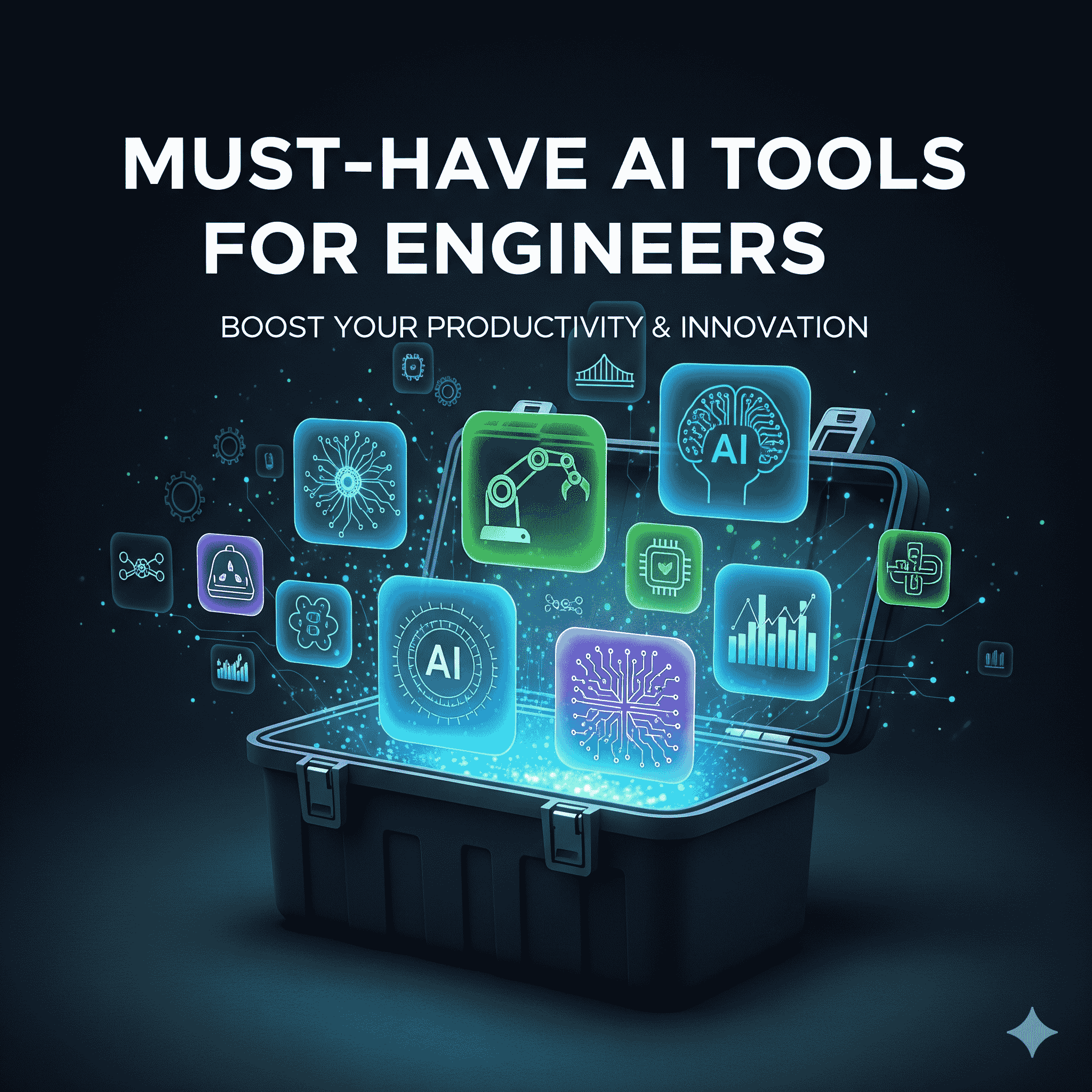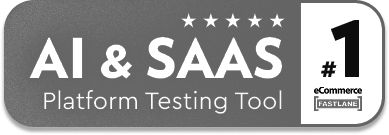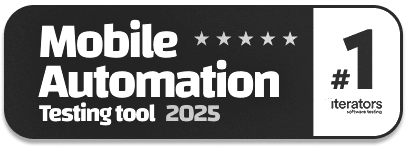Must-Have AI Tools for Engineers
|
|
These days, Artificial Intelligence (AI) plays an important role in how engineers design, analyze, and manage complex tasks across every domain, including mechanical, electrical, civil, software, and so on. AI is involved at every level, from automating repetitive tasks to generating design solutions, and AI tools are becoming increasingly indispensable for modern engineering.
An engineer needs to not only master core technical skills but also have the knowledge of AI to stay efficient and competitive. Similar to data engineering, AI engineering has also become popular due to heightened AI demand.
Along with AI skills, various AI tools are revolutionizing engineering workflows. These tools are used in various tasks such as design, simulation, code generation, data analysis, and project management.
But which are the must-have AI tools an engineer requires?
In this article, we will prepare a list of AI tools that engineers can use during the various stages of a project.

AI in Engineering
AI can be leveraged in two ways in engineering:
- To be a part of the application under development, as a feature or capability.
- To assist engineers through the various stages of an application’s lifecycle.
If it’s the first option, then you need someone specialized in AI technologies – an AI engineer.
Who is an AI Engineer?
By definition, an AI engineer is an individual who builds, maintains, and optimizes AI systems or applications.
This role is becoming increasingly popular due to the rise of AI’s adoption in software development. We now need skilled professionals who can create and manage AI-based applications. They also design predictive models and develop autonomous systems. An AI engineer not only possesses theoretical knowledge but also practical skills to apply to real-world problems.
So, to perform all these functions, they need programming skills as well as several other skills such as machine learning, mathematical and statistical skills, etc.
AI Engineering Tools
The following table summarizes the various skills an AI engineer needs:
| Skill | Examples |
|---|---|
| Programming Language |
|
| Machine Learning |
|
| Big Data |
|
| Cloud Services |
|
| Machine Learning Frameworks/ Libraries |
|
| Data Management and MLOps Tools |
|
| Code and Prompt Engineering Assistants |
|
Note: It is not necessary to acquire each and every skill. Depending on the role and project requirements, an AI engineer may or may not acquire all the skills.
Related reads:
AI Tools for Engineers
Even if you aren’t an AI engineer, the one who develops AI applications, you can still leverage AI-based tools and products to improve your output as an engineer.
Here are the primary benefits of why adding AI tools to your process is going to help you:
Benefits of AI Tools in Engineering
- Automate Repetitive Tasks: AI-powered code completion tools such as GitHub Copilot offer real-time suggestions and automate repetitive tasks improving coding ability. Developers can thus focus on more complex problem-solving tasks.
- Improve Security: AI tools utilize advanced AI models to identify security issues and manage technical debt in real-time, and thus enhance software security and quality. This approach improves reliability and also saves developers from security potential breaches.
- Become Creative: AI tools for design streamline creative workflows by allowing users to generate design drafts from text prompts. Using these tools, creators can produce high-quality content efficiently.
- Research becomes fun: AI tools offer learning through the visual organization of complex ideas. They make learning more engaging and tailored to individual needs by integrating various resources and providing real-time AI-based answers.
- Collaborate with ease: Collaboration AI tools integrate AI-driven features throughout the software development lifecycle and improve team productivity. They also streamline workflows and ensure that the entire team is aligned on their project.
- No fixation on Boring Tasks: AI tools provide real-time transcriptions and summaries, allowing participants to focus on discussions rather than manual note-taking, ensuring that important information is captured and shared efficiently.
Related reads:
- AI in Engineering: How AI is changing the software industry?
- AI in Engineering – Ethical Implications
- How to Increase Engineering Output Using AI
Types of AI Tools for Engineers
Code Generation and Assistance
AI-powered code assistants are some of the most widely adopted tools for engineers. They act as “pair programmers,” providing real-time suggestions and generating code snippets. These tools can help you with:
- Code Completion
- Code Generation
- Debugging and Code Analysis
Testing and Quality Assurance
AI tools are revolutionizing software testing by making test automation accessible to all team members. By automating the creation and execution of test cases, manual efforts are reduced and test coverage improves. These tools can help you with:
- Automated Test Generation
- Self-Healing Tests to Reduce Test Maintenance
- Visual and Performance Testing
- Testing AI-based Applications
Project Management and Documentation
Beyond coding and testing, AI tools can streamline the overall project workflow, making it easier for engineering teams to collaborate and stay organized. These tools can help you with:
- Documentation
- Project Management
- Meeting Transcription
List of AI Tools for Engineers
Based on the above categories, we have compiled a list of AI-based tools an engineer should be familiar with.
1. testRigor
testRigor is a generative AI-based test automation tool and enables users to create and maintain automated tests using simple English commands. testRigor offers a no-code solution for UI end-to-end testing, making it accessible to testers of all skill levels, including those without coding experience. It uses AI to generate and adapt test cases to changes in the application, thus accelerating the testing process.
Use Cases:
Test Automation, End-to-end testing, Generative AI test creation, Cross-browser testing.
Benefits:
- Generative AI for Test Creation: With generative AI, testRigor can automatically generate test scripts based on plain English descriptions.
- Self-Healing Tests: testRigor has a self-healing capability with which AI algorithms can dynamically adapt tests to changes in the application’s UI or functionality. This minimizes the need for manual maintenance.
- Plain English Commands: Users create and modify tests using simple English, making the process more intuitive and accessible to all.
- Cross-System Testing: testRigor supports end-to-end testing across various platforms, including web, mobile, native desktop, Salesforce, ServiceNow, and more.
- Scalability and Efficiency: With testRigor, test case creation is faster with significantly reduced maintenance efforts.
- Testing AI Features: Along with a host of capabilities, testRigor can test AI features like LLMs using simple English. This makes testing modern applications, be it web or mobile, easier.
With testRigor, teams can automate more tests faster with less maintenance, ultimately improving software quality and reducing costs.
2. Snyk
Snyk is a developer-first security platform that finds and fixes vulnerabilities in application code, open-source dependencies, container images, and infrastructure-as-code (IaC) configurations using AI-powered intelligence. It integrates into the DevOps pipeline and provides continuous security. It enables developers to identify and remediate risks early in the software development lifecycle, thus reducing application risk and improving security posture.
Use Cases:
Secure software supply chain, Application security, shift-left security, and cloud-native architecture protection.
Benefits:
- Reduced Risk: Snyk proactively identifies and fixes critical vulnerabilities, minimizing the possibility of security breaches and attacks.
- Enhanced Developer Productivity: Snyk embeds security into the development workflow, enabling developers to focus on building secure solutions.
- Lower Costs: The overall cost is lowered since it prevents vulnerabilities and breaches.
- Improved Software Quality: Snyk helps build more secure and reliable applications that entice customers.
- Better Governance: Snyk provides visibility into the security of all application assets and tools that enforce and manage security policies, which leads to better governance.
3. JIRA with AI
The “Jira AI Assistant” refers to the AI features within Atlassian’s products, particularly Jira and Jira Service Management, known as Atlassian Intelligence. It uses artificial intelligence and natural language processing to help users with tasks like summarizing tickets, drafting and refining issue descriptions, generating child issues, creating rules, and providing 24/7 customer support through virtual service agents.
Use Cases:
Generate test cases from user stories, automate knowledge base creation, optimize workflow, and streamline service desk operations.
Benefits:
- Increased Productivity: Jira AI assistant automates routine tasks and provides intelligent assistance. This helps teams focus on higher-value work and complete tasks faster.
- Improved Efficiency: Processes become more efficient and manual effort is reduced with streamlined workflows, faster issue resolution, and optimized service desk operations.
- Better Collaboration: AI in Jira improves communication by offering instant context, summarizing discussions, and connecting teams with the right information, leading to better collaboration.
- Enhanced User Experience: AI-powered virtual agents provide faster support to customers and internal users.
- Scalability: Teams can scale their operations easily and manage complex projects by automating processes and reducing bottlenecks.
4. ChatGPT
ChatGPT is a powerful AI tool that can be used in association with other AI tools to enhance creativity and productivity. It generates text, translates languages, and creates code. It can also be used with other tools to automate tasks, build AI applications, and analyze data. ChatGPT and similar tools can also solve math problems, generate code for embedded systems, and write scripts.
Use Cases:
Content creation, code generation, debugging, documentation, and problem-solving.
Benefits:
- ChatGPT provides code suggestions, thus accelerating development.
- Helps search for syntax or APIs faster, thus reducing overall coding time.
- It can also provide troubleshooting help.
5. OpenAI Codex
OpenAI Codex is an artificial intelligence model developed by OpenAI that is designed to generate code from natural language prompts. It’s a fine-tuned descendant of GPT-3, explicitly optimized for programming tasks. Codex CLI, an open-source tool, was also introduced, bringing Codex’s capabilities to local terminal software.
Use Cases:
Code completion, bug fixing, and test generation
Benefits:
- Accelerated Development: Codex automates code completion, bug fixing, and test generation, thus making development more accessible and efficient.
- Parallel Completion: Codex works on multiple tasks in parallel, thus reducing the time it takes to complete tasks and increasing efficiency.
- AI-based Development: Codex helps developers review workflows by checking AI-generated pull requests. Developers can spot formatting problems and prompt Codex to fix the issues.
6. Amazon CodeWhisperer
Amazon CodeWhisperer is an AI coding companion that provides real-time, contextual code suggestions and generates full functions based on natural language comments and existing code.
It has trained billions of lines of code, supports various programming languages and IDEs, and has features such as security scanning for vulnerabilities and a reference tracker to identify similarities with open-source training data.
Use Cases:
Code generation and completion, Boilerplate code reduction, Onboarding and Learning, Improving Code Quality and Best Practices
Benefits:
- Boosted Productivity: CodeWhisperer provides code suggestions and error detection capabilities that drastically reduce development time.
- Enhanced Code Quality: It performs real-time code reviews and refactoring suggestions, keeping the codebase clean and error-free.
- Improved Collaboration: Seamlessly collaborate with team members through shared coding experiences and instant feedback.
- Codebase Understanding: Developers can easily grasp the complex code structures using code exploration features.
7. Cursor
Cursor is an AI-first code editor that integrates generative AI into development workflows. It provides features such as AI-powered code completion and generation, natural language editing, integrated debugging and chatbots, and codebase awareness.
Use Cases:
Accelerated software development, rapid prototyping, Debugging and Error Resolution, and educational purposes
Benefits:
- Increased Productivity: Developers can focus on more intense tasks and write code faster as Cursor automates repetitive tasks and offers intelligent suggestions.
- Reduced Errors: Code written is reliable and high-quality, with proactive error detection and correction.
- Faster Development Cycles: Speeds up various stages of development, from prototyping to debugging and refactoring.
- Enhanced Collaboration: Team workflows and collaboration are improved with features like shared projects and real-time assistance.
- Lower Stress: Common coding tasks are simplified, and cognitive load and stress on developers are reduced.
8. Tabnine
Tabnine is a AI-powered coding assistant and is designed to be controlled by engineering team. It boosts productivity by suggesting code completions while you type. Tabnine focuses on privacy, security, and license compliance.
Use Cases:
Faster and secure development, License compliance
Benefits:
- Reduces human typing errors by suggesting code completions.
- Accelerate and simplify the code development process.
- Helps develop secure applications.
9. GitHub Copilot
GitHub Copilot is an AI-based coding assistant that works with a code editor to help developers write code efficiently. It uses advanced ML to suggest code snippets, complete functions, and generate functions based on user code context. This accelerates the development process and improves productivity.
Use Cases:
Problem-solving, Code generation, debugging, and documentation.
Benefits:
- It helps maintain the code rhythm by providing coding suggestions and completing code.
- Focuses more on problem-solving and less on syntax.
- Works with a code editor to write high-quality and efficient code.
10. Mintlify
Mintlify provides AI-powered, interactive, and highly customizable documentation platforms for developers and includes features like Markdown-native content, GitHub integration, an AI assistant, and live code demos.
Use Cases:
API Documentation, SDK Guides, Knowledge Bases, and Changelog Management.
Benefits:
- API Playground: Users can test and explore APIs directly in their docs.
- Visitor Authentication: Docs are secured using customizable access controls.
- User Feedback: Documentation and code are kept in perfect harmony.
- Fully Customizable: Documents can be tailored with custom components and JS + CSS.
11. Vercel v0.dev
Vercel v0.dev is an AI-powered tool that accelerates web development by generating UI code from natural language prompts or visual inputs.
Use Cases:
Quick UI Ideation and Prototyping, Design System Component Generation, Design-to-Code Workflow Enhancement, and Internal Tool Development.
Benefits:
- Time Savings: Development time is reduced significantly by automatic UI code generation.
- Increased Productivity: More efficient workflows can be generated with faster iterations and experimentation with UI designs.
- Reduced Technical Barriers: Non-technical users, such as designers and product managers, can generate UI components and prototypes.
- Improved Accessibility: Auditing and suggestion capabilities create more accessible web interfaces.
12. Tableau with AI Insights
Tableau is fully-integrated tool with AI-plus-analytics capabilities that enables organizations to drive tangible business outcomes. It simplifies and democratizes data analysis. Tableau AI uses generative AI capabilities to understand patterns, learn from data, and create new insights to generate meaningful content from user inputs.
Use Cases:
Design KPIs, data visualization, and performance monitoring.
Benefits:
- Tableau AI connects to live engineering data sources.
- It uses natural language queries with explain data.
- It also provides predictive insights without coding.
13. DeepCode AI
DeepCode AI is an AI-based code review tool that uses ML to learn from code changes and provides feedback so that cleaner, bug-free code can be written. As DeepCode AI reviews the code, it suggests the next steps to ensure precision and timely completion.
Use Cases:
Large Language Models (LLMs) are customized enterprise solutions for large organizations
Benefits:
- DeepCode AI provides accurate auto-fixes to code issues.
- It offers context-aware suggestions for fixes in the codebase.
14. Otter.ai
Otter.ai is an AI tool that transcribes spoken audio into text. It is mainly used for note-taking, meeting summarization, and content creation.
Use Cases:
Meetings, Sales, and client calls, Internal collaboration, HR, and Recruiting
Benefits:
- Enhanced Productivity: Otter’s AI agent automatically transcribes meetings, freeing up time from manual note-taking. Team members can focus on discussions rather than note-taking.
- Actionable Insights: AI identifies and flags key action items and decisions, thus simplifying follow-up tasks and streamlining workflows.
- Searchable Notes: All recorded conversations are transcribed into editable, searchable transcripts that are easy to maintain and read.
Automated Content Creation: Otter AI Chat can generate content based on meeting discussions, such as blog posts or follow-up emails.
- Improved Decision-Making: More strategic and informed decisions can be made with organized notes and insights.
15. AI-Powered Collaboration Platforms (e.g., Slack GPT, Microsoft Copilot)
AI-based collaboration tools enhance teamwork by using AI to automate tasks, streamline communication, and improve overall efficiency. Tools like Slack GPT and Microsoft Copilot integrate AI capabilities into existing collaboration platforms, making them smarter and more effective. These tools use AI to summarize discussions, schedule tasks, and auto-tag issues.
Use Cases:
Team communication, AI-powered code review, and sprint planning.
Benefits:
- Collaboration tools provide AI-written meeting summaries.
- They can suggest documentation updates and code refactoring.
- Collaboration tools integrate with Git, Jira, and other design tools.
Specialized AI Engineering Tools
1. TensorFlow
TensorFlow is an open-source library from Google that helps engineers develop and train ML models. It has high-powered APIs and robust flexibility, and it simplifies the process of implementing and deploying ML at any scale. TensorFlow is important for building intelligent systems such as computer vision applications, autonomous robots, and Internet of Things (IoT) solutions.
Use Cases:
System optimization, custom deep learning models, signal processing, and image recognition.
Benefits:
- TensorFlow is highly customizable and scalable.
- It has a vast community and documentation.
- The library supports cross-platform and GPU-accelerated training.
2. PyTorch
PyTorch is an open-source ML library that provides deep learning and complex computations capabilities. PyTorch is an excelled choice for creating, experimenting, and implementing deep learning models.
Use Cases:
Custom deep learning models, image recognition, and system optimization.
Benefits:
- PyTorch is suitable for projects that require faster development.
- PyTorch can handle large and complex projects that are not manageable by TensorFlow.
- It is incredibly flexible and has rich APIs for the library extension.
3. Scikit-Learn
Scikit-Learn is an AI tool in ML community for automation processes. It is a free ML library for Python and is simple and efficient. It provides various classification, regression, and clustering algorithms, that simplify ML tasks.
Use Cases:
Feature extraction tasks, supervised ML algorithms for data analysis and data mining, and cross-validation.
Benefits:
- Scikit-Learn uses a single CPU and is built on SciPy.
- The tool is focused on data modeling and not manipulation.
- It can be used for projects that have lots of calculations, such as data mining.
4. SolidWorks with AI-Powered Design Assistance
SolidWorks uses an AI-based design assistant that is a suite of tools. It learns from user behavior and provides intelligent suggestions to workflows. The tool can also automate tasks, offer real-time feedback, and help troubleshoot.
Use Cases:
Product design, 3D modeling, and mechanical engineering.
Benefits:
- SolidWorks provides AI-driven generative design capabilities.
- It offers real-time collaboration with cloud-based environments.
The tool also suggests design improvements based on simulation data.
5. Jupyter Notebooks with AI Libraries
The Jupyter Notebook is an open source, browser-based tool and it allows users to create and share documents that contain live code, visualizations and text. It can also be combined with AI libraries like scikit-learn, pandas, and NumPy to analyze large datasets, create visualizations, and build predictive models.
Use Cases:
Data analysis, model development, simulation, and visualization.
Benefits:
- Jupyter Notebooks provide an Interactive environment for iterative experimentation.
- It offers seamless integration with Python-based AI tools.
- The tool is ideal for analytics, signal processing, and control systems.
6. IBM Watson Studio
IBM’s Watson Studio is a collaborative platform used to build, train, and deploy ML models. Teams can streamline their workflows using a wide range of data sources it supports. Engineers can use Watson Studio to deploy and manage AI models in production environments in industries lie manufacturing.
Use Cases:
Predictive maintenance, AI model development, and data visualization.
Benefits:
- IBM Watson Studio supports AutoML for quick model generation.
- It integrates with cloud and edge devices.
- Watson Studio offers collaboration features for engineering teams.
7. Edge Impulse
Edge Impulse is the leading platform to build, refine, and deploy ML models to edge devices. Using Edge Impulse, AI capabilities can be added to devices. Edge Impulse offer drag-and-drop tools to deploy AI models onto edge devices and microcontrollers helping engineers to work with smart devices.
Use Cases:
Computer vision, embedded AI, and real-time ML deployment.
Benefits:
- Edge Impulse offers no-code/low-code environments for rapid prototyping.
- It provides real-time testing on hardware.
- The tool is excellent for robotics, wearables, and IoT.
8. KNIME
KNIME (Konfiner) Analytics Platform is an open-source software used for data analytics, reporting, and integration. KNIME provides a visual, workflow-based environment in which users can access, blend, analyze, and visualize data. KNIME is ideal for visual interface applications and supports drag-and-drop workflows to automate model building, reporting, and data preprocessing.
Use Cases:
Visual programming for data science and machine learning.
Benefits:
- KNIME is open-source and highly extensible.
- It can connect to Python, R, and TensorFlow.
- It is suitable for engineers analyzing sensor or operational data.
Conclusion
As the engineering landscape is evolving rapidly, AI is at the forefront of this transformation. AI tools are now essential companions, whether you are simulating thermal flows, programming embedded devices, designing next-gen electric vehicles, or analyzing operational data.
By integrating AI tools into daily operations, AI:
- Reduces time spent on repetitive or low-value tasks.
- Improves the reliability and quality of designs.
- Collaborates more effectively with different departments.
- Makes innovative data-driven decisions.
By embracing AI, engineers are not just keeping up with current trends but they are leading the charge into the future of efficient, innovating, and smart engineering.
| Achieve More Than 90% Test Automation | |
| Step by Step Walkthroughs and Help | |
| 14 Day Free Trial, Cancel Anytime |












